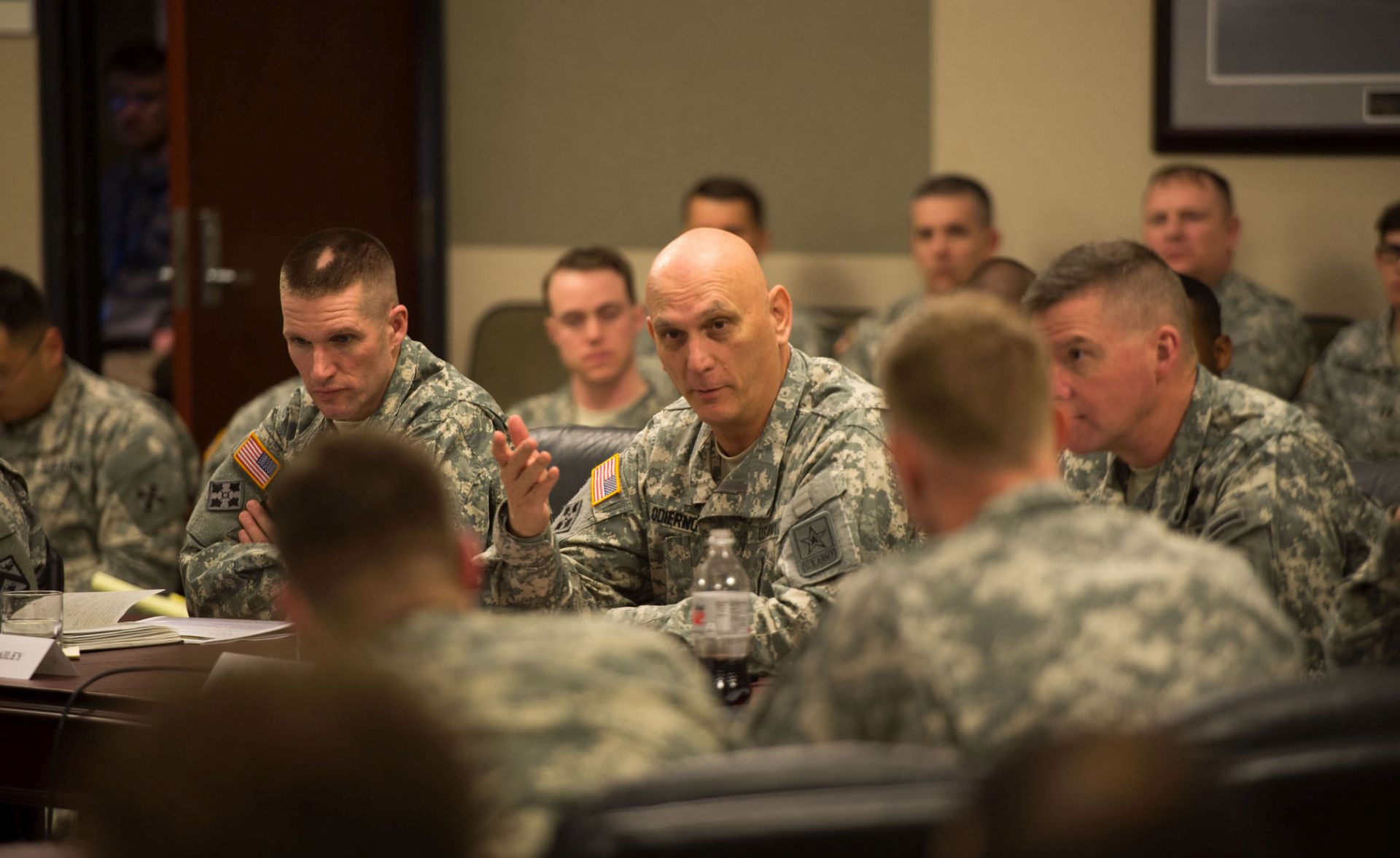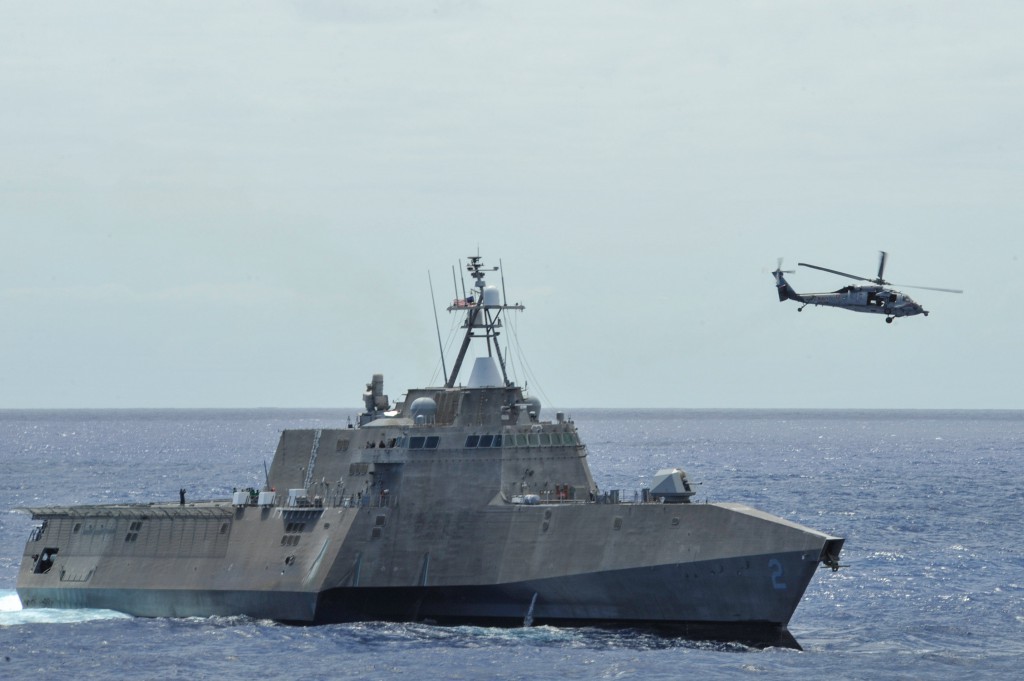“Five, 10, 15, 20 years from now, you’ll be executing our future strategy to meet complex problems we have around the world,” said Army Chief of Staff Gen. Ray Odierno.
The general spoke Feb. 26, to an audience of 84 captains from around the Army, as part of the three-day Solarium 2015 conference at the Command and General Staff College here.
As the Army prepares to execute its strategy: “The U.S. Army Operating Concept: Win in a Complex World,” or AOC, Odierno said he wanted to get “those unique perspectives captains bring,” as they will be implementing this strategy in the future.
Odierno’s remarks came during an informal discussion he and other senior leaders had with the captains, who were divided into seven groups, each group tasked with taking on different aspects of the Army Operating Concept and coming up with ideas and solutions for its operationalization.
The first group discussed better ways to develop agile and adaptive leaders who can operate in the complex and chaotic environment the Army expects for future conflicts.
Captains concluded that while the Army is good at developing junior and company-grade officers within their core competencies and warfighting functions, it could use some improvements in better broadening the expertise they need to operate as a regionally aligned and engaged force.
GLOBAL PERSPECTIVES
Capt. Matt Etheridge said the Army must put more emphasis on incorporating cultural, regional expertise and language, in the same way it now evaluates science, technology, engineering, and mathematics. He said the Army should make some measure of cultural, regional, language, or CREL, experience a requirement for promotion.
Experiences through fellowships, learning a language and studying abroad are a few of the ways to do this, he said. It would also be good to recognize officers who develop CREL skills on their own.
The Officer Record Brief is probably the best place to capture this experience, Odierno replied, adding that he liked the thought process on this but was unsure he could get everyone to those types of assignments except for short duration events or perhaps to incorporate more aspects of it into professional military education.
Etheridge said exposing junior officers to joint commands earlier in their careers would be particularly beneficial.
“I’ve always believed that the first six or seven years should focus on developing core competencies within your branch through company command or equivalent,” Odierno said. “That should be your total focus. Then, when that’s done, we focus on broadening assignments to include potential joint assignments.”
But, “once leaders get into a joint environment, they lack familiarity.” That experience would be more useful early in their careers, Etheridge said. The captains, incidentally, were encouraged to provide their unvarnished feedback to Odierno, whether they agreed or disagreed.
PERFORMANCE FEEDBACK
Capt. Jeffrey Bernard, also a member of the first group, said the Army lacks an effective how-to guide for counseling Soldiers.
Odierno said the new support form on the Officer Evaluation Report was designed to do just that. The intent, he said, was that it would drive leaders to sit down with subordinates and discuss not just performance but leadership traits.
For example, a leader might advise that a Soldier is a great motivator but perhaps needs some work on communications skills, Odierno said. The idea is to present honest feedback about what others think a Soldier’s strengths and weaknesses are and to encourage improvements.
“Is that happening in your experience?” Odierno asked.
It varies from leader to leader, Bernard said.
Gen. David G. Perkins, commander, U.S. Army Training and Doctrine Command, asked if Bernard interacted with his commanders on a routine basis and thought their feedback was a form of counseling.
Bernard said he did, acknowledging that informal counseling was as valuable as formal sit-down types.
Perkins said that for effective counseling to occur, leaders and subordinates have to communicate well. If Soldiers “don’t have a good relationship with their bosses they go in different directions, because they don’t understand intent, and it’s hard to get that from a counseling form.”
COUNSELING VERSUS MENTORSHIP
Bernard said he thought mentorship was an art, while counseling was more a science, meaning that the mechanics of it could be taught in a formalized manner. However, not everyone can be a mentor, he said. It takes a personality match.
Odierno described his own experiences, saying he never asked someone to be his mentor. “It just happened. Frankly, the person might not even have known he was my mentor.”
Looking back, Odierno said he had about five mentors throughout his career. These were people he “liked,” he said. “I liked how they acted and handled themselves. So, I made sure I learned as much as I could from them.”
The chief said he agreed with Bernard that personality plays a big part. “You can respect someone and recognize they’re a good officer, but if his or her personality doesn’t fit your leadership style,” it won’t work.
The takeaway, Odierno said, is that while formal counseling is important from an institutional perspective, informal counseling and mentoring are major factors in leader development. And that is something that needs to be fostered in an increasingly complex world, where even junior leaders need to make split-second decisions that have far-reaching impacts.
BROADENING TRAINING
Capt. Rebecca Cooper, speaking for the second group, discussed how to prepare leaders for operating with joint and partner agencies. She said the Army must embrace complexity and change by training as it fights: in a robust environment, with multiple, nontraditional partners.
This type of training could be accomplished using existing capabilities, she said. She cited the National Guard’s “Exportable Combat Training Capabilities,” or XCTC, as an example of a model on how it could be done.
The XCTC provides an experience similar to a combat training center for its Soldiers at home station or at a regional training center, minimizing cost and time away from home and jobs. Within an XCTC-type framework, she said, personnel from the other components and services, the Department of State and other agencies the Army operates with overseas could participate.
In such an environment, Cooper said, her knowledge of electronic warfare would benefit by working with her Navy electronic warfare counterpart.
The partnering could involve military police working with their civilian counterparts, comparing tactics, techniques and procedures. Public affairs units could partner with local news stations. Signal companies could partner with AT&T or Verizon in exercises, she continued.
Joint Base Lewis-McChord, Washington, would be a great place to test this out, she said, as there are multiple services and agencies located there, as well as nearby Canadian armed forces.
Capt. Matt Brian, also of group two, said inviting a person from the U.S. Agency for International Development’s Office of Transition Initiatives to a maneuver advanced leader course would educate Soldiers about negotiation techniques and cross-cultural exchanges. Exchanges with foreign services officers could also be an option.
“We’d like to see memorandums of agreement or understanding that enable us to partner with agencies,” Cooper said.
A lot of that type of training is happening at the combat training centers, Odierno said. “Would you replace that?”
No, not replace that, she replied. It would help to push mission command opportunities to lower levels and broaden the experiences of junior officers early on. It would also expand effectiveness of home-station training.
“I like the concept,” said Odierno, noting that XCTC is expensive since it is contractor-based, but other approaches could be examined.
CRITICAL THINKING
Brian said Soldiers at all levels need to be trained better in critical thinking skills, as they are often faced with complex challenges and dilemmas in chaotic environments.
Development of critical thinking situations could be injected into the non-commissioned education system as well professional military education courses such as the Warrior Leader Course, he said. The situations should be “open-ended, forcing leaders to identify the best way to approach situations, rather than just in a linear fashion with only one right answer.”
ABOUT SOLARIUM
The first Solarium, convened at the national security level by President Dwight D. Eisenhower in 1953, focused on Cold War strategy.
The second Solarium was convened by Odierno in July 2014 to discuss key issues impacting the Army: talent management, vision and branding, culture, training, education and mission command. About 100 captains from throughout the Army met at the Command and General Staff College to discuss their topics and present their recommended solutions to the chief.











